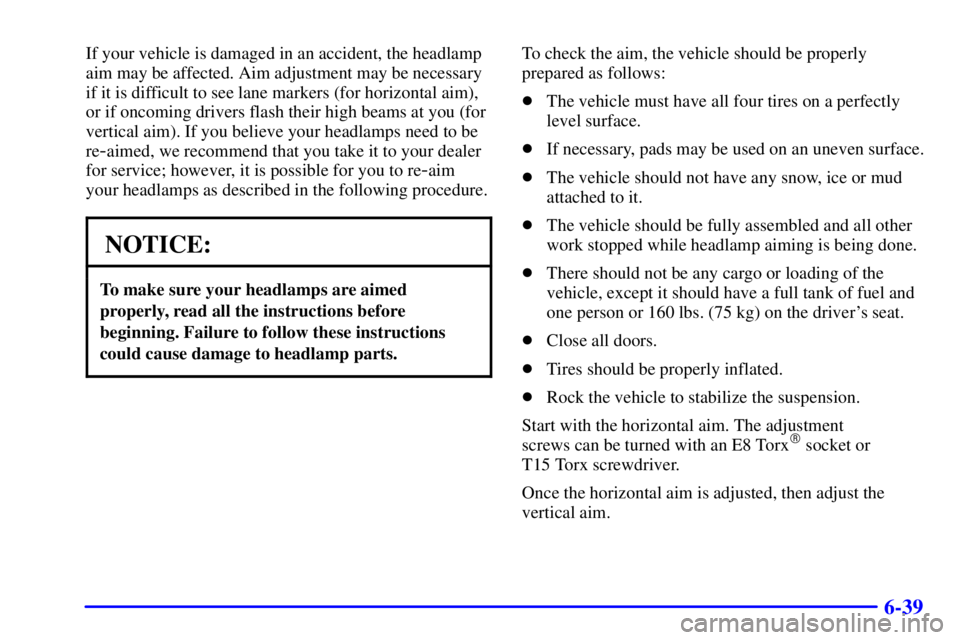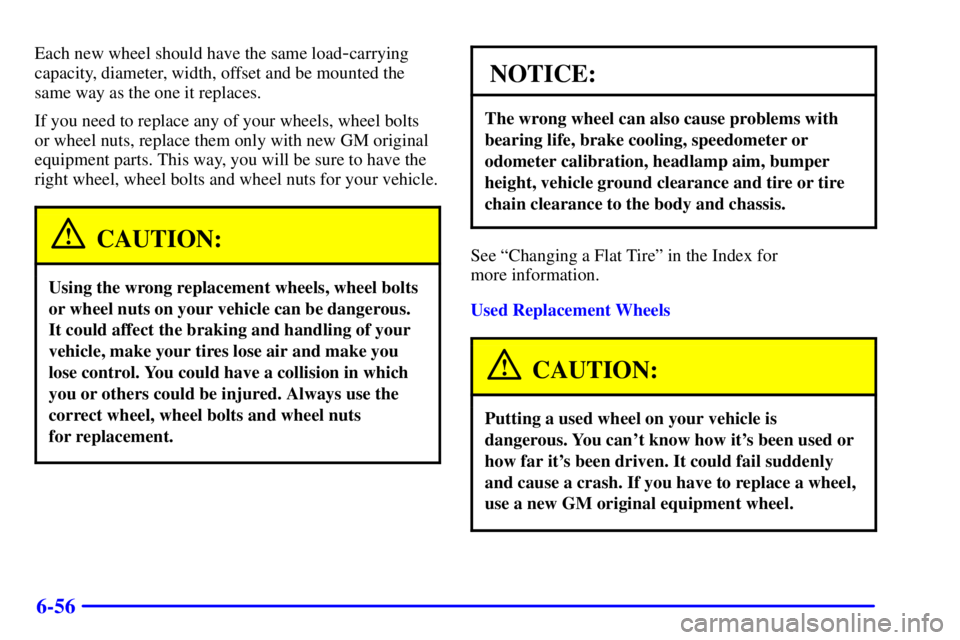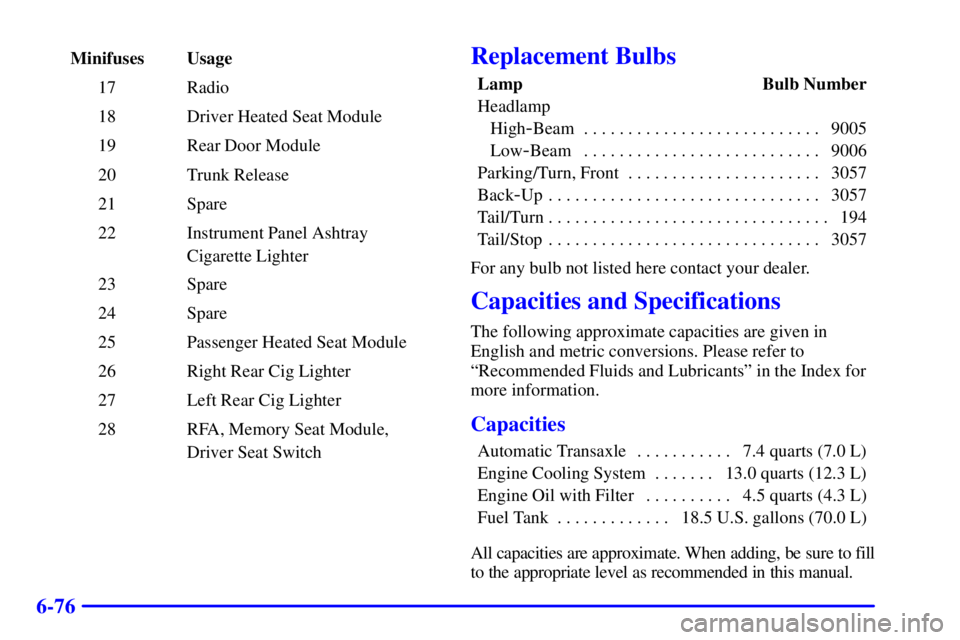Page 301 of 395
6-37
2. Pull the headlamp assembly away from the vehicle.
3. Remove the bulb socket
by turning it one
-quarter
turn counterclockwise,
while pressing it firmly.
Then pull it out. You can
use a tool to remove the
bulb socket if you are
unable to do it by hand.
4. Remove the wire connector from the bulb by
lifting the lock tab and pulling it away from the
plastic base.
5. Replace the old bulb with a new bulb. Make sure not
to touch the new bulb element with your fingers, as
the oils on your hands will reduce bulb life.
6. Reverse Steps 1 through 4 to reassemble the
headlamp assembly.
Page 302 of 395
6-38
When reassembling, make sure to align the pin at the
outboard edge of the headlamp assembly to the plastic
retainer at the outboard edge of the vehicle.Headlamp Aiming
The headlamp aiming device is under the hood, directly
behind the headlamps.
Your vehicle has a headlamp system equipped with
horizontal and vertical aim indicators. The aim has been
pre
-set at the factory and should need no further
adjustment. This is true even though your vertical and
horizontal aim indicators may not fall exactly on the
ª0º (zero) marks on their scales.
Page 303 of 395

6-39
If your vehicle is damaged in an accident, the headlamp
aim may be affected. Aim adjustment may be necessary
if it is difficult to see lane markers (for horizontal aim),
or if oncoming drivers flash their high beams at you (for
vertical aim). If you believe your headlamps need to be
re
-aimed, we recommend that you take it to your dealer
for service; however, it is possible for you to re
-aim
your headlamps as described in the following procedure.
NOTICE:
To make sure your headlamps are aimed
properly, read all the instructions before
beginning. Failure to follow these instructions
could cause damage to headlamp parts.
To check the aim, the vehicle should be properly
prepared as follows:
�The vehicle must have all four tires on a perfectly
level surface.
�If necessary, pads may be used on an uneven surface.
�The vehicle should not have any snow, ice or mud
attached to it.
�The vehicle should be fully assembled and all other
work stopped while headlamp aiming is being done.
�There should not be any cargo or loading of the
vehicle, except it should have a full tank of fuel and
one person or 160 lbs. (75 kg) on the driver's seat.
�Close all doors.
�Tires should be properly inflated.
�Rock the vehicle to stabilize the suspension.
Start with the horizontal aim. The adjustment
screws can be turned with an E8 Torx
� socket or
T15 Torx screwdriver.
Once the horizontal aim is adjusted, then adjust the
vertical aim.
Page 304 of 395
6-40
1. Turn the horizontal
aiming screw (A)
until the
indicator (B) is
lined up with zero.
2. Turn the vertical aiming screw (C) until the level
bubble (D) is lined up with zero.Front Turn Signal
1. Once the headlamp assembly has been removed,
reach down from the top of the vehicle and, while
pressing the lock tab on the socket, turn the socket
one
-quarter turn counterclockwise and pull it out.
2. Remove the old bulb by
pulling it straight out of
the socket.
3. Replace the bulb and turn the bulb assembly back
into place.
Page 320 of 395

6-56
Each new wheel should have the same load-carrying
capacity, diameter, width, offset and be mounted the
same way as the one it replaces.
If you need to replace any of your wheels, wheel bolts
or wheel nuts, replace them only with new GM original
equipment parts. This way, you will be sure to have the
right wheel, wheel bolts and wheel nuts for your vehicle.
CAUTION:
Using the wrong replacement wheels, wheel bolts
or wheel nuts on your vehicle can be dangerous.
It could affect the braking and handling of your
vehicle, make your tires lose air and make you
lose control. You could have a collision in which
you or others could be injured. Always use the
correct wheel, wheel bolts and wheel nuts
for replacement.
NOTICE:
The wrong wheel can also cause problems with
bearing life, brake cooling, speedometer or
odometer calibration, headlamp aim, bumper
height, vehicle ground clearance and tire or tire
chain clearance to the body and chassis.
See ªChanging a Flat Tireº in the Index for
more information.
Used Replacement Wheels
CAUTION:
Putting a used wheel on your vehicle is
dangerous. You can't know how it's been used or
how far it's been driven. It could fail suddenly
and cause a crash. If you have to replace a wheel,
use a new GM original equipment wheel.
Page 336 of 395
6-72
Minifuses Usage
22 Run/Crank
23 Powertrain Control Module
24 Parking Lamp
25 Hazard Flashers
26 Spare
27 Spare
28 ABS #2
Mini Relays Usage
29 Ignition
30 Horn
31 Cool Fan #2
32 Starter
33 Air Pump
34 Cool Fan SP
35 Cool Fan 1Micro Relays Usage
36 Air Conditioning Clutch
37 Fuel Pump
Maxifuses Usage
38 Bat #1
39 Blower Motor
40 Cool Fan 2
41 Headlamp
42 BAT #2
43 Ignition
44 Starter
45 ABS
46 Fuse Puller
Page 340 of 395

6-76
Minifuses Usage
17 Radio
18 Driver Heated Seat Module
19 Rear Door Module
20 Trunk Release
21 Spare
22 Instrument Panel Ashtray
Cigarette Lighter
23 Spare
24 Spare
25 Passenger Heated Seat Module
26 Right Rear Cig Lighter
27 Left Rear Cig Lighter
28 RFA, Memory Seat Module,
Driver Seat SwitchReplacement Bulbs
Lamp Bulb Number
Headlamp
High
-Beam 9005. . . . . . . . . . . . . . . . . . . . . . . . . . .
Low
-Beam 9006. . . . . . . . . . . . . . . . . . . . . . . . . . .
Parking/Turn, Front 3057. . . . . . . . . . . . . . . . . . . . . .
Back
-Up 3057. . . . . . . . . . . . . . . . . . . . . . . . . . . . . . .
Tail/Turn 194. . . . . . . . . . . . . . . . . . . . . . . . . . . . . . . .
Tail/Stop 3057. . . . . . . . . . . . . . . . . . . . . . . . . . . . . . .
For any bulb not listed here contact your dealer.
Capacities and Specifications
The following approximate capacities are given in
English and metric conversions. Please refer to
ªRecommended Fluids and Lubricantsº in the Index for
more information.
Capacities
Automatic Transaxle 7.4 quarts (7.0 L). . . . . . . . . . .
Engine Cooling System 13.0 quarts (12.3 L). . . . . . .
Engine Oil with Filter 4.5 quarts (4.3 L). . . . . . . . . .
Fuel Tank 18.5 U.S. gallons (70.0 L). . . . . . . . . . . . .
All capacities are approximate. When adding, be sure to fill
to the appropriate level as recommended in this manual.
Page:
< prev 1-8 9-16 17-24